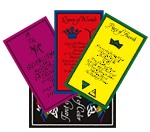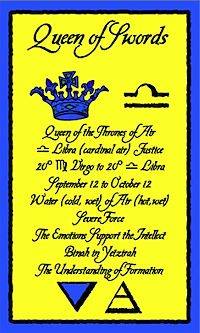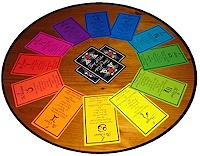By Sheri Harshberger
I didn't have enough time last month to review this deck, Leisa ReFalo's Tarot of Color, in tandum with her new journals (versions of which feature this deck), so I thought I would make sure to do it this month!
The Tarot of Color is a very interesting deck created and published by Leisa ReFalo, an amazing person who many interested in Tarot may recognize as the trailblazer in Tarot Podcasting. She is the producer of the Tarot Connection podcasts, available through iTunes and on her website, http://www.tarotconnection.net. In addition to publishing her own deck, she is responsible for making previously out-of-print, yet keystone, decks like Ellen Lorenzi-Prince's Tarot of the Crone, and Robert Place's Alchemical Tarot, available again.
The 80-card deck is shipped in a clear plastic case that opens lengthwise and snaps to securely close. On the side of the closure, there is a business card-sized area that holds the label and ISBN information. Within the plastic case, the deck is packaged in a specially made black velveteen bag that displays the Tarot of Color logo in bright gold gilt.
The cards are approximately the same size as a standard deck, and the card stock is sturdy. My deck came with a slight, lengthwise bend, similar to the bend that many of my older, well-used decks have developed. Because of this, I had to keep reminding myself that this was a new deck. The deck shuffles crisply, and while the cards don't stick during shuffling, they want to clump a bit when I fan them. I don't think this is a problem at all; I have several other decks that were "clumpers" out of the box.
This deck is called an "Esoteric Attribution Deck" and follows the traditional, 78-card deck structure with regards to the card titles. The 22 Majors and 56 Minors are all accounted for. The Fool card is numbered as 0, Strength is 8, and Justice is 11. The traditional suits of Cups, Pentacles, Swords, and Wands are used. But that is where the similarities between this deck and others end; not only are the pips non-scenic, they and the Majors are also non-illustrated!
Each card has its title across the top of the card, followed by a rank or astrological symbol, followed by a list of traditional, historical, esoteric, or astrological attributes associated with the card. Then, in list format, follows a series of attributes from the Tree of Life, seasons, keywords, associated Hebrew letter (from Hermetic Qabalah), elemental dignity, and color association. The cards themselves are brightly colored and carry the whole color or combinations of colors that coincide with its respective element or elements. The deck is keyed on the Golden Dawn, which assigns the Hebrew letter Aleph to the Fool. In the courts, although the card titles are King, Queen, Knight, and Page, the first lines of the attributes list refer to them as Prince, Queen, Lord, and Princess. What was really thought provoking for me was noticing that each member of the courts was elementally described using 2 elements, sometimes with the same element being used twice, perhaps for extra emphasis. For example, the Knight of Wands is associated with double Fire, the Queen of Cups with double Water, the King of Swords with double Air, and the Page of Pentacles with double Earth.
The deck doesn't come with a little white book (LWB), because it carries all the information needed on each card. There is also a website devoted to the use of the deck and system, at http://www.tarotofcolor.com. As I mentioned previously, this is an 80-card deck, made up of the 78 Tarot cards as well as 2 additional cards. One of the cards has a color-coded schematic of the Tree of Life, showing the placement of the Majors within it. The other card shows the unique symbols and keywords that Leisa has assigned to the elements, and also shows the rules associated with the dignities.
You may be asking, "If there are no pictures, how can I read with it?" When I asked myself this, I was reminded of the first deck I got that was black and white. I was fascinated by it. I asked if I was supposed to color it! At that point I was told, "Yes, yes you are... but let the reading do it." That was an epiphany for me - I was no longer constrained to a locked-in color scheme with that deck. This deck has given me another epiphany... reading without imagery breaks the constraints to locked-in imagery. What would pop into my head when I drew these cards in a reading? Wow. I end up using a deck of my OWN design in my head WITH the added dimension of color as an indicator of self-state. The cards are brightly colored and are intended to tap into and speak to us about the color energies around us. Our chakras and auras are color-based... feng shui and other practices strive to bring positive energies through color into our lives. This deck is an excellent tool for bringing color balance into one's life. To quote Leisa on her website, "The absence or presence of a color in a Tarot reading is provocative."
I, like many others, have struggled with courts in decks. I have to say, one of the decks with the worst treatments for the courts is The Witches’ Tarot, in which all the respective court ranks look absolutely the same, except with different backgrounds and different colors of their clothing. One of the best I've worked with is the Vanessa Tarot, whose courts are all distinctly different and they are all "doing something" that can help with interpretation, but I have problems translating these scenes to other decks. Then I explored this deck, and the question, “What is a member of a court like?” led me to come up with the visuals based on the attributes provided on the card. I found that I "built" the court in my head... not just appearance, but also feelings, and impressions. They became real people to me! The Queen of Cups became my mom, the King of Wands and the Queen of Swords are coworkers... and so on. Very cool!
This is not a deck for newbies, though. The attribution listings on the cards should not be used as a shortcut to learning Tarot - it doesn't work that way. This deck would be an excellent investment for anyone who has "grown up" in the Waite-Smith tradition and would like to expand into the other esoteric aspects of Tarot, wants to explore their own intuitive take on the cards in readings, or wishes to have a tool available to assist in understanding or journaling of the deck or decks he or she is currently using. It is an amazing tool for self-improvement and guidance.


